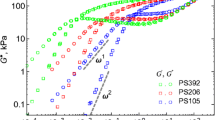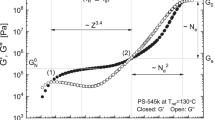Abstract
We find that symptoms of polymer melt fracture, such as a time-dependent decrease in apparent sample modulus and apparent slip, can be induced by oscillatory torsional shearing flow of polystyrene melts and solutions, even when the polymer molecular weight is below the entanglement threshold, and thre strain amplidute is as low as 3%. Visualization of samples during and after fracture show crack and bubble formation, as well as delamination of the polymer from the rheometer tools. For polystyrene melts, the critical stress for fracture is τ* ≈ 0.1–1.0 MPa, depending on polymer molecular weight and temperature, and for solutions it is as low as 5 × 103 Pa. Since “constitutive instabilities” require the viscoelastic properties to be highly nonlinear, our observations of melt fracture in unentangled polymers at shearing strains well within the linear viscoelastic range rule out this mechanism for some of our experiments, and show that melt fracture is not always caused by constitutive instabilities.
Similar content being viewed by others

References
Benbow JJ, Lamb P (1963) New aspects of melt fracture. SPE Trans 3:7–17
Demarquette NR, Dealy JM (1992) Nonlinear viscoelasticity of concentrated polystyrene solutions: sliding plate rheometer studies. J Rheol 36:1007–1032
Denn MM (1990) Issues in viscoelastic fluid mechanics. Annu Rev Fluid Mech 22:13–34
Doi M, Edwards SF (1979) Dynamics of concentrated polymer systems. Part 4. Rheological Properties. J Chem Soc, Faraday Trans II, 75:38–54
Ferry JD (1980) Viscoelastic properties of polymers. 3rd ed John Wiley & Sons, New York
Gleissle W (1974) Schub- und Normalspannungsmessungen an Silikonölen bei hohen Schergefällen mit einem neuen Kegel-Platte-Rheometer. Coll Polym Sci 252:848–853
Hatzikiriakos SG, Dealy JM (1991) Wall slip of molten high density polyethylene. I. Sliding plate rheometer studies. J Rheol 35:497–523
Hatzikiriakos SG, Dealy JM (1992a) Wall slip of molten high density polyethylene. II. Capillary rheometer studies. J Rheol 36:703–741
Hatzikiriakos SG, Dealy JM (1992b) Role of slip and fracture in the oscillating flow of HDPE in a capillary. J Rheol 36:845–884
Hill DA, Hasegawa T, Denn MM (1990) On the apparent relation between adhesive failure and melt fracture. J Rheol 34:891–918
Hutton JF (1969) Fracture and secondary flow of elastic liquids. Rheol Acta 8:54–59
Kalika DS, Denn MM (1987) Wall slip and extrudate distortion in linear low-density polyethylene. J Rheol 31:815–834
Kinlock AJ, Young RJ (1983) Fracture behaviour of polymers. Elsevier, New York
Kolkka RW, Malkus DS, Rose TR (1991) Finite rise time step strain modeling of nearly monodisperse polymer melts and solutions. Rheol Acta 30:430–446
Kulicke W-M, Jeberien H-E, Kiss H, Porter RS (1979) Visual observation of flow irregularities in polymer solutions at theta-conditions. Rheol Acta 18:711–716
Larson RG (1992) Instabilities in viscoelastic flows. Rheol Acta 31:213–263
Lee CS, Tripp BC, Magda JJ (1992) Does N1 or N2 control the onset of edge fracture? Rheol Acta 31:306–308
McLeish TCB, Ball RC (1986) A molecular approach to the spurt effect. J Polym Sci 24:1735–1745
Moynihan RH, Baird DG, Ramanathan R (1990) Additional observations on the surface melt fracture behavior of linear low-density polyethylene. J Non-Newt Fluid Mech 36:255–263
Paul DR, Southern JH (1975) The role of entanglements in the elastic fracture of polymer solutions. J Appl Polym Sci 19:3375–3380
Petrie CJS, Denn MM (1976) Instabilities in polymer processing. AIChE J 22:209–236
Piau JM, El Kissi N, Tremblay B (1990) Influence of upstream instabilities and wall slip on melt fracture and sharkskin phenomena during silicones extrusion through orifice dies. J Non-Newt Fluid Mech 34:145–180
Ramamurthy AV (1986) Wall slip in viscous fluids and influence of materials of construction. J Rheol 30:337–357
Tanner RI, Keentok M (1983) Shear fracture in cone-plate rheometry. J Rheol 27:47–57
Vinogradov GV, Malkin AYa, Yanovskii YuG, Borisenkova EK, Yarlykov BV, Berezhnaya GV (1972) Viscoelastic properties and flow of narrow distribution polybutadienes and polyisoprenes. J Polym Sci A-2 10:1061–1084
Winey KI, Patel SS, Larson RG, Watanabe H (1993) The interdependence of shear deformations and block copolymer morphology. Macromolecules 26:2542–2549
Author information
Authors and Affiliations
Rights and permissions
About this article
Cite this article
Chen, YL., Larson, R.G. & Patel, S.S. Shear fracture of polystyrene melts and solutions. Rheola Acta 33, 243–256 (1994). https://doi.org/10.1007/BF00366951
Received:
Revised:
Issue Date:
DOI: https://doi.org/10.1007/BF00366951



